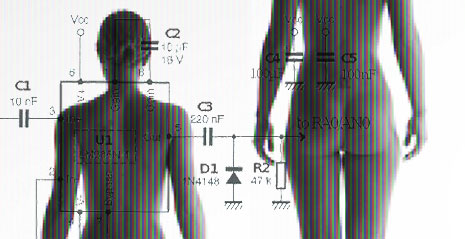
Electronic communication networks now construct much of our understanding of reality. The distinct categories of identity that develop in these digital realms along with the interface between the body and these electric fantasies create new possibilities for what some call “computer cross-dressing.” Just as “real world” drag queens disrupt gender categories that were previously considered static, computer cross-dressers deconstruct, explore, and reconstruct new identities. Communities of computer cross-dressers destabilize identity categories so that they are constantly in transit, bearing no stable ontological relationship between what is on the World Wide Web and who is behind the computer.
Many argue that cyberspace allows the disabled, socially-marginalized, and any so-called “Other” to transcend whatever offline constraints inhibit their ideal self-expression. A man wishing to be a woman can develop a three-dimensional female avatar and no one would be the wiser. A woman could adopt a form that puts Tommy Lee to shame and harpoon a whale; it would not be the strangest thing to happen on the Internet. Those confined to a wheel chair could suddenly decide to fly. Christopher Reeves could actually become Superman (too soon?)!
According to Deanna Weber, author of Subjectivity and Gender-Identity in Cyberspace, every manifestation of identity in cyberspace is a representation without a direct antecedent grounded in “reality.” The fluid nature of electronic identity construction allows individuals to define and reinterpret their identity, avoiding the pitfalls of essentialism. The allure of the Internet is that people can do precisely the things that the “real world” denies.
In the “real world”, the individuals who compose a movement are exposed and “stuck” in their own bodies, unable to “transcend” the truly physical consequences that often follow self-expression. The transgender high school student, who attends a conservative private school, would be systematically beaten if Perez Hilton “outed” him or her. When a five year-old asks whether the post-op transgender woman who lives next door is a man or a woman, then said transgender’s “real world” efforts to disrupt gendered identity might be successful – though not in the way she hoped.
The real world has the cruel tendency to reduce earnest attempts to deconstruct gender and other categories of identity to mere parlor tricks…
The real world has the cruel tendency to reduce earnest attempts to deconstruct gender and other categories of identity to mere parlor tricks, which is ironic considering that the object of transgression is an illusion. For scholars like Judith Halberstam, white male monopolization of masculinity simultaneously prevents its “progressive” reformation, even as it prevents lesbians and straight women from making it their own.
Reality has been intolerant toward women seeking to dress themselves in female masculinity. As Rachel Adams, the Associate Director of American Studies at Columbia University, notes, for the last several hundred years Western culture has failed to recognize “gender indeterminacy.” Women who defy stable gendered categories are labeled as tomboys or butch because they are perceived as being functionally distinct from what women should be. Society allows for masculine female heroines like Sarah Connor or Lara Croft, but only as long as they are thoroughly heterosexual; however, when a strong female heroine no longer needs dick she becomes a dangerous character – one who might just castrate the men around her simply to fill a trophy case.





No Comments so far ↓
There are no comments yet...Kick things off by filling out the form below.